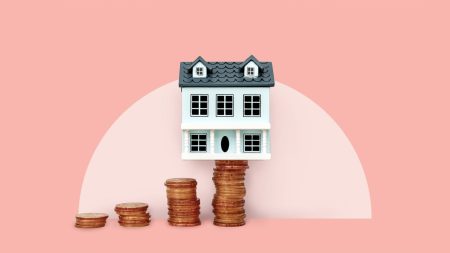The Good Brigade/Getty Images; Illustration by Grant Crowder/Bankrate
Key takeaways
- Existing-home sales rose 0.8 percent in May to a seasonally adjusted annual rate of 4.03 million. Sales slowed 0.7 percent from a year ago.
-
The median existing-home sale price rose 1.3 percent from May 2024 to $422,800, marking the 23rd straight month of year-over-year price increases.
- The inventory of unsold existing homes rose 6.2 percent from the previous month to 1.54 million at the end of May, the equivalent of 4.6 months’ supply at the current sales pace.
Existing-home sales remain slow even as home prices set new records. The median home sale price for May was $422,800, the highest May median on record. But May 2025 home sales slowed to an annual pace of just 4.03 million, the slowest number for the month since the dark days of May 2009, the National Association of Realtors (NAR) reports.
NAR Chief Economist Lawrence Yun called the pace of sales “sluggish.” He pointed to affordability and mortgage rates as headwinds. The average 30-year fixed mortgage rate rose from a low of 6.2 percent in September 2024 to above 7 percent in early 2025. It stood at 6.86 percent as of June 18, according to Bankrate’s weekly survey of large lenders.
With home prices historically high, affordability challenges remain daunting for homebuyers. Lower mortgage rates would relieve some of that pain: “The relatively subdued sales are largely due to persistently high mortgage rates,” Yun said. But lower rates also could lure more buyers into the market, further fueling prices.
The fate of the housing market in the coming months will be dictated in part by the direction of mortgage rates.
— Mark Hamrick, Bankrate Senior Economic Analyst
“The fate of the housing market in the coming months will be dictated in part by the direction of mortgage rates, as well as the health of the broader economy,” says Mark Hamrick, Bankrate’s senior economic analyst. “The market could benefit from a combination of tailwinds, if they were to develop and are sustained.”
Existing-home sales up from last month but down from last year
The count of existing-home sales incorporates all completed resales, including single-family houses, condos, townhouses and co-ops. According to NAR, the number of sales nationally rose from the previous month to an annual pace of 4.03 million transactions in May.
In May, existing-home sales in the Northeast increased 4.2 percent month-over month to an annual rate of 500,000, up 4.2 percent from a year ago. In the Midwest, sales rose 2.1 percent to an annual rate of 990,000, up 1 percent from a year ago.
Existing-home sales in the South rose 1.7 percent to an annual rate of 1.84 million, down 0.5 percent from last year. The West was the only region that saw a decline, with sales retreating 5.4 percent to an annual rate of 700,000, down 6.7 percent from a year ago.
Days on market
Properties typically stayed on the market for 27 days in May, down from 29 days in April. Selling times are a crucial measure at any time of year, but especially during the peak spring and summer selling seasons.
Home prices still historically high
The nationwide median sale price for existing homes in May was $422,800 — the highest-ever price for the month. While that’s slightly below June 2024’s all-time high of $426,900, it’s still an increase of 1.3 percent from last year. This marks 23 consecutive months of year-over-year price increases.
Regionally, prices were mixed. May’s median price in the Northeast was $513,300, a 7.1 percent increase from a year ago. The median in the Midwest was $326,400, up 3.4 percent year-over-year.
In the South, the median was $367,800, down 0.8 percent from last year. The West continues to have the highest median price by far at $633,500, up 0.5 percent from May 2024.
First-time homebuyers made up 30 percent of sales in May, an improvement over the all-time low of 26 percent in August and September. Cash sales accounted for 27 percent of transactions in May, up from 25 percent in April.
Supply again improves year-over-year
The inventory of unsold existing homes jumped 6.2 percent from the previous month to 1.54 million at the end of May, or the equivalent of 4.6 months’ supply at the current monthly sales pace. That’s a healthy 20.3 percent increase from a year ago. But, while buyers are gaining bargaining power, inventory still remains a bit below the 5 or 6 months typically considered the mark of a balanced market.
“We are still short on inventory,” Yun said. “We know there’s a lot of talk about excess inventory, especially in Texas and Florida.”
Why we ask for feedback
Your feedback helps us improve our content and services. It takes less than a minute to
complete.
Your responses are anonymous and will only be used for improving our website.
Help us improve our content
Read the full article here









